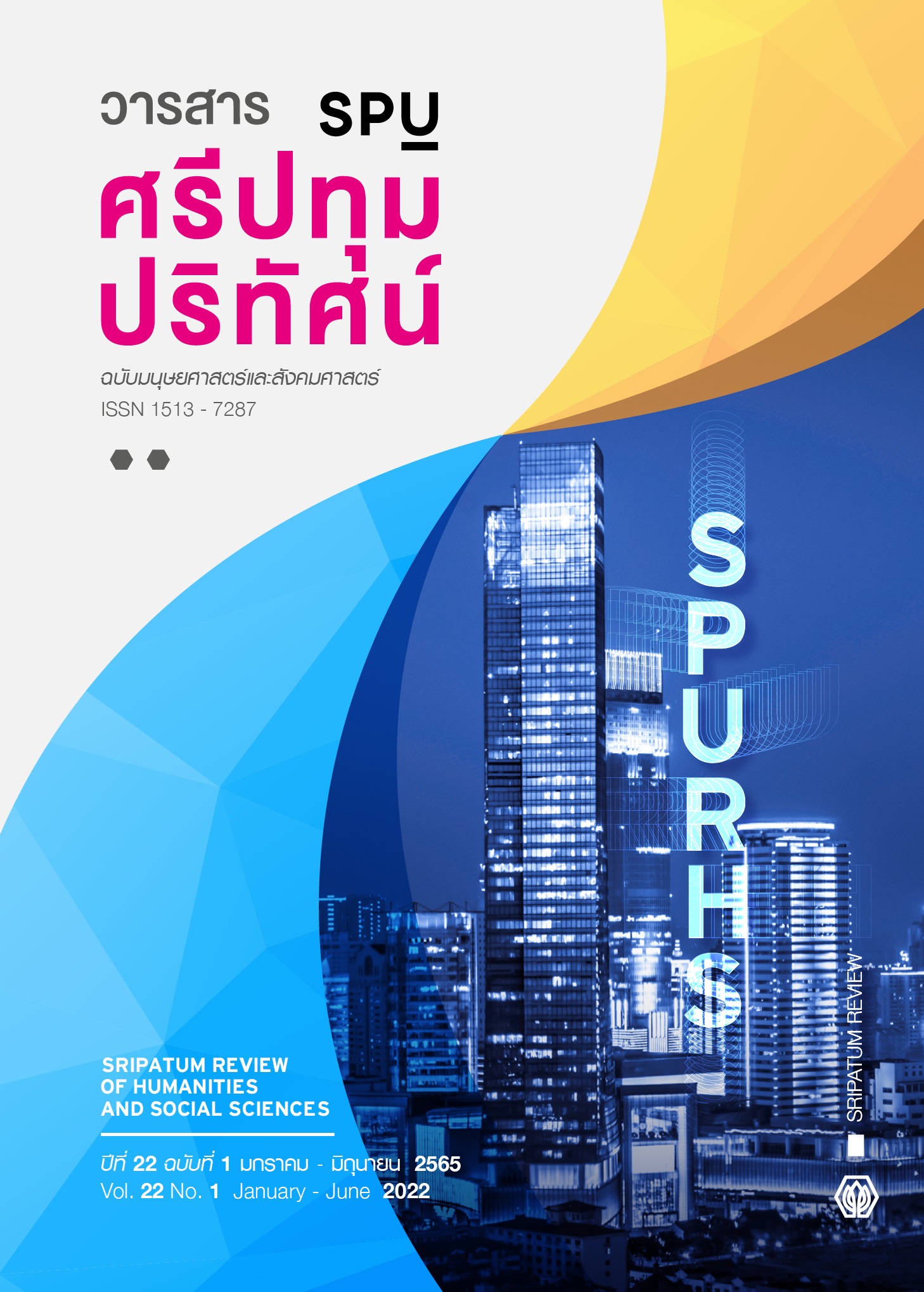Variations in Transliterated English in Advertisements for UNIQLO Products
Main Article Content
Abstract
The objective of this research article is to present the results of qualitative research on variations in transliterated English words in advertisements for UNIQLO products. The scope of the research covers transliterated English words that are varied from transliteration rules found in advertisements in newsletters of UNIQLO Thailand from October 1, 2019 to September 30, 2020. There are 51 out of 153 transliterated words that are varied from the transliteration rules of the Office of the Royal Society. The research found 17 variations: (1) variation in the initial consonant, (2) variation in the final consonant, (3) variation in the marked silent letter, (4) variation in the final consonant and the marked silent letter, (5) variation in vowel, (6) variation in the vowel and final consonant, (7) variation in the marked short vowel, (8) variation in the final consonant and the marked short vowel, (9) variation in the vowel and marked short vowel, (10) variation in the tone, (11) variation in the initial consonant and tone, (12) variation in the final consonent and tone, (13) variation in the marked silent letter and tone, (14) variation in the vowel and tone, (15) variation in the marked short vowel and tone, (16) variation in the initial consonant, vowel and tone, and (17) variation in the initial consonant, final consonant, vowel, and tone.
Article Details

This work is licensed under a Creative Commons Attribution-NonCommercial-NoDerivatives 4.0 International License.
1. กองบรรณาธิการสงวนสิทธิ์ในการพิจารณาและตัดสินการตีพิมพ์บทความในวารสาร
2. บทความทุกเรื่องจะได้รับการตรวจสอบทางวิชาการโดยผู้ทรงคุณวุฒิ แต่ข้อความและเนื้อหาในบทความที่ตีพิมพ์เป็นความรับผิดชอบของผู้เขียนแต่เพียงผู้เดียว มิใช่ความคิดเห็นและความรับผิดชอบของมหาวิทยาลัยศรีปทุม
3. การคัดลอกอ้างอิงต้องดำเนินการตามการปฏิบัติในหมู่นักวิชาการโดยทั่วไป และสอดคล้องกับกฎหมายที่เกี่ยวข้อง
References
Bunnag, O. (2018). The Variations of Spelling in the Standard Form of Information Technology Transliteration of Undergraduate Students in Different Programs. Interdisciplinary Studies Journal, Faculty of Social Sciences and Humanities, Mahidol University, 18(1), 221-265. (in Thai)
Chaikiattitham, R. (2016). The Use of Changed Pronunciation of English Loan Words in Thai. RMU.J. (Humanities and Social Science), 10(3), 21-32. (in Thai)
Chapimon, K. (2017). The Thai Orthographical Forms Produced by the First Year of Undergraduate Students: Prince of Songkla University and Phuket Rajabhat University. Journal of Humanities, Naresuan University, 14(1), 47-60. (in Thai)
Kanchanawan, N. (2011). Problems in Thai Usage. 4th Ed. Bangkok: Ramkhamkaeng University. (in Thai)
Laulertvorakul, A. (2010). Pali and Sanskrit Loanwords. In W. Changkhuanyuen et al. (Eds.), Thai Foundation Volume 2: Sound System, Thai Alphabet, Reading Words and Spelling Words (2nd Ed.). (pp. 113-197). Bangkok: Thai Language Institute, Bureau of Academics and Educational Standards, Office of the Basic Education Commission, Ministry of Education.(in Thai)
Naksakul, K. (2013). Sound System of the Thai Language.7th Ed. Bangkok: Academic Publishing Project, Faculty of Arts, Chulalongkorn University. (in Thai)
Pancharoen, A. (2018). Influences of Foreign Languages on Thai. 3rd Ed. Bangkok: Ramkhamhaeng University. (in Thai)
PPTV Online. (2021). “UNIQLO Thailand” Never-ending Improvement in the Past 10 Years. [Online]. Retrieved October 24, 2021, from: https://www.pptvhd36.com/news/%E 0%B9%80%E0%B8%A8%E0%B8%A3%E0%B8%A9%E0%B8%90%E0%B8%81%E0%B8% B4%E0%B8%88/157652 (in Thai)
Prasithrathsint, A. (2005). Language in Thai Society. 4th Ed. Bangkok: Chulalongkorn University. (in Thai)
_______. (2012a). Thai Language and Society. In P. Nimmanhemin, et al. (Eds.), Thai Foundation Volume 4: Culture of Thai Usage (2nd Ed.). (pp. 1-21). Bangkok: Thai Language Institute, Bureau of Academics and Educational Standards, Office of the Basic Education Commission, Ministry of Education. (in Thai)
_______. (2012b). Changes of the Thai Language in Social and Cultural Contexts. In P. Nimmanhemin, et al. (Eds.), Thai Foundation Volume 4: Culture of Thai Usage (2nd Ed.). (pp. 129-150). Bangkok: Thai Language Institute, Bureau of Academics and Educational Standards, Office of the Basic Education Commission, Ministry of Education. (in Thai)
Prime Minister’s Office. (1989, September 14). Announcement of Prime Minister’s Office on English-Thai Transliteration Rules. The Royal Gazette, Volume 106, No. 153. (in Thai)
Purinthrapibal, S. (2018). Influence of English in French Pronunciation of Secondary Schools Learners in Fourteen Southern Provinces. Journal of Information, Office of Academic Resources and Information Technology, Bansomdejchaopraya Rajabhat University, 17(1), 143-155. (in Thai)
Srisa-ard, B. (2017). Introduction to Research. 10th Ed. Bangkok: Suwiriyasan. (in Thai)
Thongsakul, R. (2019). English Transliterated Words Appeared in Vogue Thailand Magazine. Liberal Arts Review, 14(1), 54-66. (in Thai)
Warottamasikkhadit, U. (2020). Introduction to Linguistics. 24th Ed. Bangkok: Ramkhamhaeng University Press. (in Thai)


